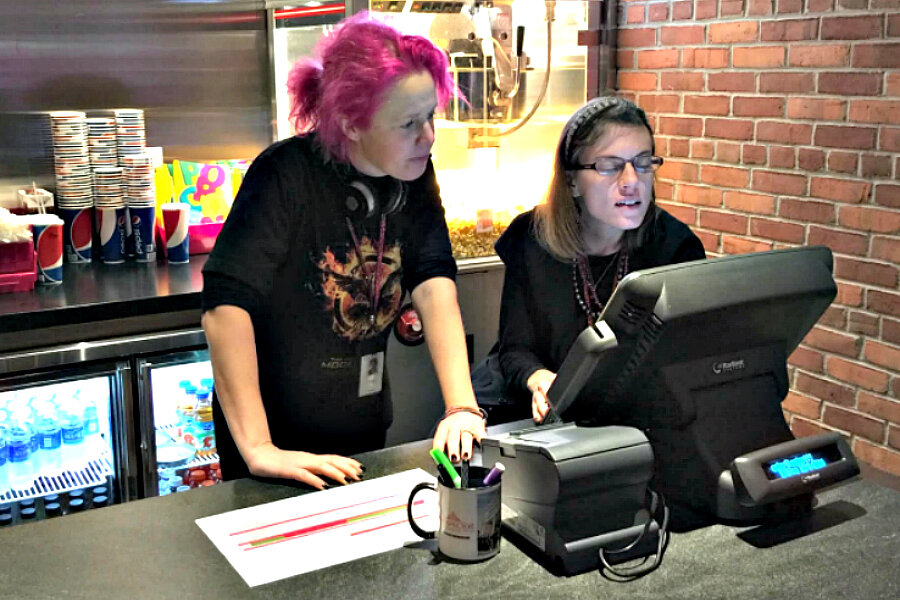Prospector Theater helps disabled people entertain new prospects
Loading...
| RIDGEFIELD, Conn.
It started with a red light.
In 2011 Ridgefield, Conn., resident Valerie Jensen was stopped at a traffic light on Prospect Street, just in front of an empty building. The brick structure had first opened its doors in 1939 as a movie theater. Years later it became a bank. But now the structure was to be razed.
Ms. Jensen had a sudden inspiration for a different plan. At the time she was president of SPHERE, an organization that serves adults with developmental disabilities. She knew if she could persuade town planners to repurpose the building, she could give the adults she worked with a renewed sense of purpose.
And so the Prospector Theater was born.
Featuring first-run movies, the nonprofit movie theater provides educational and employment opportunities for adults with developmental disabilities. And with its cafe, restaurant, and smartly dressed ushers, the theater harks back to the golden age of cinema.
“We are returning the cinema to what movie going used to be like. People will be dazzled by the fantastic customer service. And with that I hope their attitudes will be opened and changed about hiring people with disabilities,” Jensen says. “We want to break the cycle of unemployment.”
Nearly 25 years after the passage of the Americans with Disabilities Act, unemployment of working-age people with disabilities remains high. More than 80 percent of people with disabilities are unemployed, according to September 2014 Bureau of Labor Statistics figures.
At the Prospector employees are called Prospects. That’s because Jensen wants them to think of the theater as merely a steppingstone to employment elsewhere.
“Our goal is to have people leave us,” she says, wearing the same black trousers and T-shirt as all the Prospects.
Of the theater’s 70 Prospects, 16 work full time and 54 work part time. Those with disabilities receive additional job training.
For example, Kris Mann works as an usher. He loves editing and so he works an hour or two a day learning photo editing. In this way the theater parallels a vocational school. Prospects may work the cashier for most of their day, but if they have an interest in art or cooking they can spend time each day trying out something different.
Mr. Mann was working at Stop & Shop when Jensen approached him to apply for a job at the Prospector.
“We are different and we are better,” Mann told him.
The theater opened its doors Nov. 21 with screenings of “The Hunger Games: Mockingjay Part 1” and “Interstellar.” Screenings continue throughout the day.
“We want to break the stigma that movies are only for the nighttime,” Mike Santini, the theater’s director of development, says. “Daytime employment is very important for those with developmental disabilities. They often don’t have transportation to get to jobs at night.”
Mr. Santini, who was born and raised in Ridgefield, says he’s excited to give back to his community.
“We think we have something very special here,” he says. “Our goal is to create a unique experience, where everything is designed with our mission in mind.”
Indeed, the theater represents what happens when a community comes together.
Doyle Coffin Architecture, a local architectural firm, designed the building and Raffaele Gallo, a local chef, created the menu. The stately red brick building now houses four theaters, a cafe, and a restaurant. The largest theater seats 162 people, and the smallest seats 16 people.
Everything was designed with accessibility, inclusion, and safety in mind.
Railings run alongside every aisle, and in the two largest theaters the aisles are wide enough to accommodate motorized scooters and wheelchairs. Handicapped seats are scattered among regular theater chairs in every theater. This lets friends and family sit together.
Closed captioning glasses for deaf and earphones with adjustable volume are available to those moviegoers who need them.
In a nod to the theater’s past as a bank, volunteers tiled the ceiling in the theater’s Heads Up Café with 27,000 pennies. The theme also speaks to the theater’s mission.
“If you have a job your head is held high,” Jensen says.
Jensen hopes other communities will replicate the Prospector Theater model. It takes no government funding, operating solely on donations and the money raised from ticket and concession sales as well as renting theaters out for private functions such as birthday parties and corporate events.
Shades of sapphire and emerald dominate an art print from “The Wizard of Oz,” which hangs in the theater’s lobby. The “Wizard of Oz” was one of the first movies shown in the original Prospect Theater.
“The light and color of the film dazzled moviegoers,” Santini says. “Seventy years later we want people to see people with disabilities in a whole new light.”
• To learn more visit http://www.prospectortheater.org.







